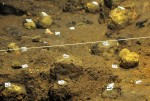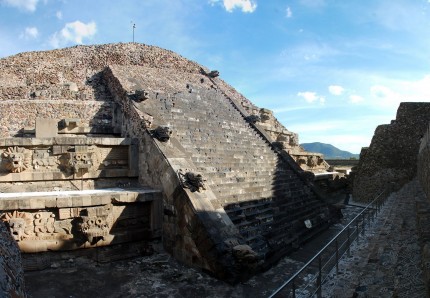 A robot named Tláloc II-TC, equipped with an infrared camera and laser scanner, has discovered three new chambers underneath the Temple of the Feathered Serpent pyramid in the Mesoamerican metropolis of Teotihuacan. He was sent down a tunnel 390 feet long that was discovered 50 feet below the surface of the temple in 2003. The tunnel had been filled with debris by the ancient Teotihuacans to block access, an effective technique since despite centuries of looting and archaeological excavations nobody had managed to breach it. It’s been a decade since the subterranean conduit was discovered and five years since excavations began, and archaeologists have only able to get a glimpse of what’s on the other side in the past few months.
A robot named Tláloc II-TC, equipped with an infrared camera and laser scanner, has discovered three new chambers underneath the Temple of the Feathered Serpent pyramid in the Mesoamerican metropolis of Teotihuacan. He was sent down a tunnel 390 feet long that was discovered 50 feet below the surface of the temple in 2003. The tunnel had been filled with debris by the ancient Teotihuacans to block access, an effective technique since despite centuries of looting and archaeological excavations nobody had managed to breach it. It’s been a decade since the subterranean conduit was discovered and five years since excavations began, and archaeologists have only able to get a glimpse of what’s on the other side in the past few months.
 They first discovered two side rooms dubbed the North Chamber and the South Chamber 236 and 242 feet respectively from the entrance. The human archaeologists couldn’t get any further than that, so they deployed Tláloc II-TC to travel another 65 feet. The terrain was uncongenial, to say the least, with the floor in some parts of the tunnel caked in sludge a foot deep. Tláloc is neither light as a feather nor stiff as a board. He weighs 77 pounds and his articulated tank-track feet kept getting stuck in the thick mud. Archaeologists believe the Teotihuacans intentionally dug down to the water table in order to build a space that recreated the conditions of the underworld.
They first discovered two side rooms dubbed the North Chamber and the South Chamber 236 and 242 feet respectively from the entrance. The human archaeologists couldn’t get any further than that, so they deployed Tláloc II-TC to travel another 65 feet. The terrain was uncongenial, to say the least, with the floor in some parts of the tunnel caked in sludge a foot deep. Tláloc is neither light as a feather nor stiff as a board. He weighs 77 pounds and his articulated tank-track feet kept getting stuck in the thick mud. Archaeologists believe the Teotihuacans intentionally dug down to the water table in order to build a space that recreated the conditions of the underworld.
Despite the navigation difficulties, Tláloc’s sensors never failed. They revealed that the tunnel has a semicircular vault and is a constant size and shape until it reaches the entryways of three previously unknown chambers. The rooms are blocked by a wall or large stone so Tláloc wasn’t able to go inside, but his scanner detected spaces that are deeper than 16 feet. The scanner can only record a maximum of five meters (approximately 16 feet) in depth. It can detect that there’s more than that to be found only it can’t find out exactly how much until it’s inside the chambers.
 They’ll need to clean out the tunnel to make it accessible to puny humans before they can reach the chambers Tláloc has found. The team hopes these rooms, hidden deep underground and deliberately made so unreachable not even highly motivated thieves and archaeologists were able to explore them for almost 2000 years after they were closed, might contain something of inestimable significance to Teotihuacan society, perhaps even the graves of the city’s founders.
They’ll need to clean out the tunnel to make it accessible to puny humans before they can reach the chambers Tláloc has found. The team hopes these rooms, hidden deep underground and deliberately made so unreachable not even highly motivated thieves and archaeologists were able to explore them for almost 2000 years after they were closed, might contain something of inestimable significance to Teotihuacan society, perhaps even the graves of the city’s founders.
 Meanwhile, archaeologists exploring North Chamber and South Chamber have discovered some unusual artifacts. They look like yellowish clay lumps ranging in diameter from 1.5 to five inches, but they’re man-made with a core of clay covered in iron pyrite. When new, they would have been spherical and the pyrite exterior, which has oxidized into duller jarosite, would have been shiny gold. The adobe walls of the chambers were also enhanced for shininess. They were coated with a powder compound of magnetite, pyrite and hematite which would have made this dark underground space gleam.
Meanwhile, archaeologists exploring North Chamber and South Chamber have discovered some unusual artifacts. They look like yellowish clay lumps ranging in diameter from 1.5 to five inches, but they’re man-made with a core of clay covered in iron pyrite. When new, they would have been spherical and the pyrite exterior, which has oxidized into duller jarosite, would have been shiny gold. The adobe walls of the chambers were also enhanced for shininess. They were coated with a powder compound of magnetite, pyrite and hematite which would have made this dark underground space gleam.
 The lumps/spheres must have been left in the space before the tunnel was closed 1800 years ago. What function they may have played is unknown at this juncture, but the prevailing hypothesis is that they were special ritual offerings of some kind. No other such artifacts have been discovered before, but many other offerings — pottery, wooden masks inlaid with rock crystal and jade — were also found in the chambers so it seems likely the balls had the same job. The pottery and masks have been dated to around 100 A.D.
The lumps/spheres must have been left in the space before the tunnel was closed 1800 years ago. What function they may have played is unknown at this juncture, but the prevailing hypothesis is that they were special ritual offerings of some kind. No other such artifacts have been discovered before, but many other offerings — pottery, wooden masks inlaid with rock crystal and jade — were also found in the chambers so it seems likely the balls had the same job. The pottery and masks have been dated to around 100 A.D.
 The Temple of the Feathered Serpent, also known as the Temple of Quetzalcoatl after the feathered serpent deity of the Aztecs who moved in to the city in the 14th century A.D. long after the original Teotihuacans had mysteriously abandoned it in the 8th century, is the third largest of Teotihuacan’s temples. The largest is the Pyramid of the Sun under which a similar tunnel was discovered in the 1970s. That excavation was less than scientifically rigorous, however, and much of the precious context information was lost. The clean, deliberate nature of this multi-season exploration, on the other hand, will ensure all of the data that can be retrieved will be retrieved. This will hopefully reveal important new information about the religious life of Teotihuacan.
The Temple of the Feathered Serpent, also known as the Temple of Quetzalcoatl after the feathered serpent deity of the Aztecs who moved in to the city in the 14th century A.D. long after the original Teotihuacans had mysteriously abandoned it in the 8th century, is the third largest of Teotihuacan’s temples. The largest is the Pyramid of the Sun under which a similar tunnel was discovered in the 1970s. That excavation was less than scientifically rigorous, however, and much of the precious context information was lost. The clean, deliberate nature of this multi-season exploration, on the other hand, will ensure all of the data that can be retrieved will be retrieved. This will hopefully reveal important new information about the religious life of Teotihuacan.

Domo arigato, Mr Roboto.
:hattip: